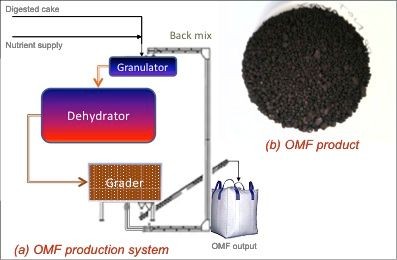Fertilisers from wastewater sludge
A European consortium developed a manufacturing process to exploit the nutrient potential of sewage sludge in agriculture, in the form of Organo-Mineral-Fertilisers (OMF).

The challenge
Every year, the EU generates over 9 million tons of sewage sludge, the residual material left from the wastewater treatment process. Today, sludge treatment and recovery processes allow transforming of part of the material for agriculture and energy applications, but the minimization and disposal of biosolids remain a key issue, both in terms of environmental and economic impact for the society.
Sludge presents a significant upcycling potential as fertiliser for agriculture, as it contains – beyond heavy metals and disease pathogens- nutrients that can improve soil structure, drainage and water holding capacity, and provide a series of component (N, P, K, S) contributing to high crop yields. Through better communication with industrial producers and effective management of their wastewater input into the sewer network, heavy metals no longer represent such a serious challenge to agricultural recycling as they were 25 years ago. On the other hand, pathogen control is readily achieved with advanced digestion processes. However, solutions must be sought to process sludge into fertiliser products that are competitive and compliant with the stringent regulations. Meeting such requirements leads to several developmental challenges, including:
Obtaining a guaranteed nutrient content in the fertiliser, though this content is highly variable in the sludgeObtaining a granular form with specific density, volume, size and size distribution to facilitate transportation, storage, and allow for an even nutrient spreading in fields.The innovation
The END-O-SLUDG consortium developed and tested a range of sludge-based fertiliser products, in the form of Organo-Mineral-Fertilisers (OMF). The product development and pilot manufacturing was carried out by the partners: equipment developer Waterleau (Belgium), sludge producer United Utilities (UK), and Engineering Services Provider Valsave Engineered Solutions (UK). The OMF manufacturing process developed relies on 5 main steps:
Digesting the sludge to recover biogas for renewable energy production.Dewatering the digested sludge to make biosolids cake,Adding vital supplements (N & P) to provide a balanced product with predictable nutrient release characteristics,Forming the fertiliser granules with a narrow particle size distribution,Removing any remaining moisture to produce a pasteurised, free flowing, and virtually dust free fertiliser.A pilot was set up at United Utilties, combining Waterleau’s sludge granulation technology with the dehydration technology supplied by Valsave. It demonstrated the ability to manufacture OMF according to strict fertiliser specifications, through a low cost, sustainable manufacturing process making use of combined heat and power (CHP) and other sources of waste heat (TRL estimated to be 7).
The OMF were field tested by Harper Adams University (UK) over 3 years on diverse range of crops. The results showed that the OMF product gave similar yields to conventional fertiliser, with very little effect on the heavy metals level and earthworm numbers in the soil. The tests also showed that the prototype OMF product could be spread accurately with conventional spreaders, a critical feature for a marketable product.
Why did it work?
END-O-SLUDG was a collaborative project funded by the EU Seventh Framework Programme (FP7), (EC Grant Agreement No. 265269) completed in December 2013. The consortium was made up of 14 Partners from 6 countries (industry academia government) covering the entire value chain from waste treatment to agriculture: this coverage ensured that the development of OMF products was highly relevant to the future end users’ needs.
Further deployment
The market data, technical performance and environmental impact data collected will be presented to regulators to support the OMF as a new sludge derivative and call for declassification of sludge as waste material. It is estimated that a potential agricultural land area of 800,000 ha in Europe could benefit from OMF application creating a market for 800,000 tonnes OMF per year. However, there is still the need for real scale demonstration of the long term viability of the process. Ideally, a demonstration plant capable of producing at least 1,000 tonnes OMF per year should be constructed and operated over 2-3 years in order to address the pre-commercialisation challenges and the residual risk linked to scaling-up.
